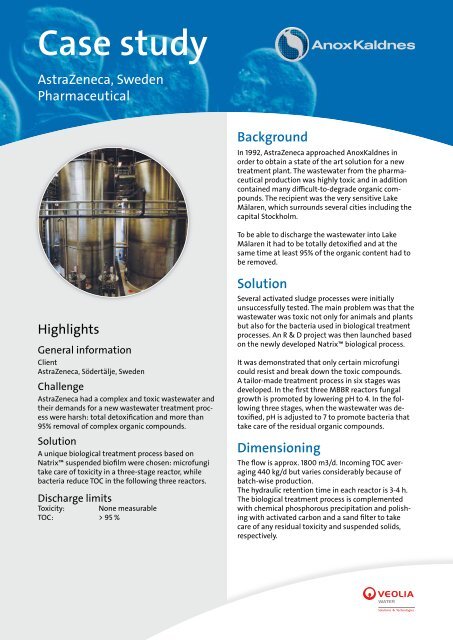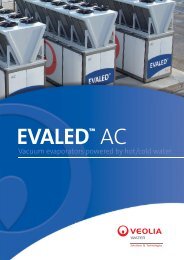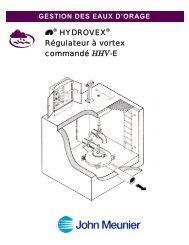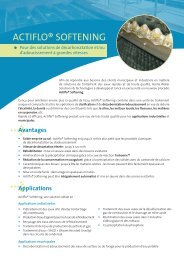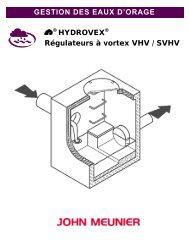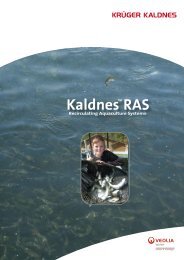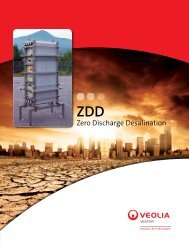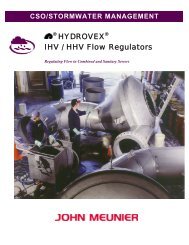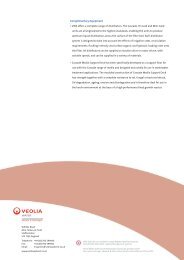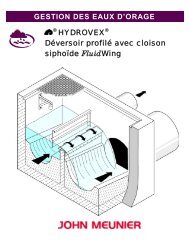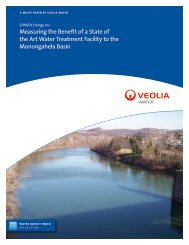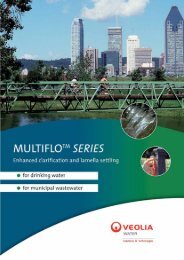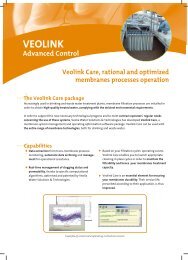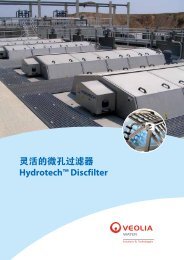Case study - Veolia Water Solutions & Technologies
Case study - Veolia Water Solutions & Technologies
Case study - Veolia Water Solutions & Technologies
You also want an ePaper? Increase the reach of your titles
YUMPU automatically turns print PDFs into web optimized ePapers that Google loves.
<strong>Case</strong> <strong>study</strong><br />
AstraZeneca, Sweden<br />
Pharmaceutical<br />
Background<br />
In 1992, AstraZeneca approached AnoxKaldnes in<br />
order to obtain a state of the art solution for a new<br />
treatment plant. The wastewater from the pharmaceutical<br />
production was highly toxic and in addition<br />
contained many difficult-to-degrade organic compounds.<br />
The recipient was the very sensitive Lake<br />
Mälaren, which surrounds several cities including the<br />
capital Stockholm.<br />
To be able to discharge the wastewater into Lake<br />
Mälaren it had to be totally detoxified and at the<br />
same time at least 95% of the organic content had to<br />
be removed.<br />
Highlights<br />
General information<br />
Client<br />
AstraZeneca, Södertälje, Sweden<br />
Challenge<br />
AstraZeneca had a complex and toxic wastewater and<br />
their demands for a new wastewater treatment process<br />
were harsh: total detoxification and more than<br />
95% removal of complex organic compounds.<br />
Solution<br />
A unique biological treatment process based on<br />
Natrix suspended biofilm were chosen: microfungi<br />
take care of toxicity in a three-stage reactor, while<br />
bacteria reduce TOC in the following three reactors.<br />
Discharge limits<br />
Toxicity:<br />
None measurable<br />
TOC: > 95 %<br />
Solution<br />
Several activated sludge processes were initially<br />
unsuccessfully tested. The main problem was that the<br />
wastewater was toxic not only for animals and plants<br />
but also for the bacteria used in biological treatment<br />
processes. An R & D project was then launched based<br />
on the newly developed Natrix biological process.<br />
It was demonstrated that only certain microfungi<br />
could resist and break down the toxic compounds.<br />
A tailor-made treatment process in six stages was<br />
developed. In the first three MBBR reactors fungal<br />
growth is promoted by lowering pH to 4. In the following<br />
three stages, when the wastewater was detoxified,<br />
pH is adjusted to 7 to promote bacteria that<br />
take care of the residual organic compounds.<br />
Dimensioning<br />
The flow is approx. 1800 m3/d. Incoming TOC averaging<br />
440 kg/d but varies considerably because of<br />
batch-wise production.<br />
The hydraulic retention time in each reactor is 3-4 h.<br />
The biological treatment process is complemented<br />
with chemical phosphorous precipitation and polishing<br />
with activated carbon and a sand filter to take<br />
care of any residual toxicity and suspended solids,<br />
respectively.
Results<br />
The treatment plant has been operational since 1997<br />
and the treatment results have been superior. In addition,<br />
the built-in tolerance to peak loads and toxicity<br />
in the Natrix biological process has provided a very<br />
stable operation that could not have been obtained<br />
with conventional treatment processes.<br />
The treated wastewater is totally detoxified by the<br />
action of the microfungi that also takes care of 80%<br />
of TOC. The bacterial communities in the following<br />
reactors remove additional organic substances so that<br />
the overall TOC removal is 97%. Approximately 80%<br />
of incoming nitrogen is removed (far more than the<br />
discharge limit). Phosphorous removal is 99%.<br />
During the years, environmental studies of the<br />
discharge point have shown that the recipient has<br />
not received any residual toxicity from the treatment<br />
process and that the amounts of nitrogen, phosphorous,<br />
COD and suspended solids have decreased in the<br />
area.<br />
info@anoxkaldnes.com<br />
www.anoxkaldnes.com<br />
AnoxKaldnes<br />
Klosterängsvägen 11A<br />
SE-226 47 Lund, Sweden<br />
Tel. +46 46-18 22 00<br />
Fax. +46 46-13 32 01


